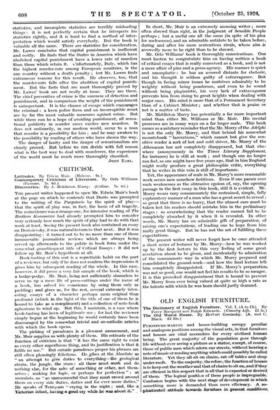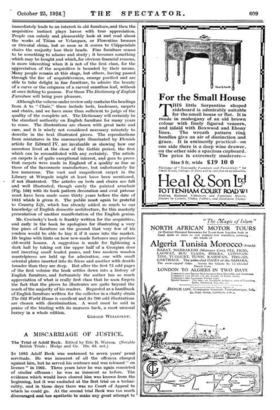OLD ENGLISH FURNITURE.
The Dictionary of English Furniture. Vol. I. (A to Ch). By Percy Macquoid and Ralph Edwards. ( Country Life. £5 Ss.) The Old World House. By Herbert Geseiusky. (A. and C.
Black. £3 10s.)
FURNITURE-MAKING and house-building occupy peculiar and analogous positions among the visual arts, in that furniture and houses are vital necessities for every civilised human being. The great majority of the population goes through life without ever seeing a picture or a statue, except, of course, those of public men which adorn our streets, without hearing a note of music or reading anything which could possibly be called literature. Yet they all sit on chairs, eat off tables and sleep under roofs. To the majority, therefore, the function of houses is to keep out the-weather and that of chairs to sit on, and. if they- are efficient in this respect that is all that is expected or desired of them. The logical position of these people is impregnable. Confusion begins with the next stage of development in which something more is demanded than mere efficiency. A so- phisticated -attitude lords _furniture in incseut co.uditions,
immediately leads to an interest in. old furniture, and then the •
• acquisitive instinct plays havoc with true appreciation. 'People can calmly and pleasurably look at and read about the works of Titian or Velazquez, or Florentine bronzes or Oriental china, but as soon as it comes to Chippendale :chairs the majority lose their heads. Fine furniture ceases to be something to admire and study ; it becomes something 1which may be bought and which, for obvious financial reasons, is more interesting when it is not of the first class, for the appreciation of the acquisitive is bounded by their means. IMany people remain at this stage, but others,. having passed 'through the fire of acquisitiveness, emerge purified and are able to take delight in fine furniture, to admire the beauty of a curve or the crispness of a carved acanthus leaf, without at once itching to possess. For these The Dictionary, of English Furniture -will bring pure pleasure.
Althoughthe volume-under review only contains the headings from. A to "Chair," these include beds, bookcases, carpets and chairs, and we have more than sufficient to judge of the quality of the complete set. The Dictionary will certainly be the standard authority on English furniture for many years to come. The illustrations are chosen with great taste and care, and it is wisely not considered necessary minutely to describe in the text illustrated pieces. The reproductions- from miniatures in the manuscripts illuminated by Flemish artists for Edward IV. are invaluable as showing how our
ancestors lived at the close of the Gothic period, the first which can be reconstituted with any certainty. The article on carpets is of quite. exceptional interest, and goes to prove that carpets were made in England of a quality as fine as those of the Savonnerie manufacture, but unfortunately far less numerous. The vast and magnificent carpet in the Library at Wimpole might at least have been mentioned,
• if not illustrated. The articles on beds- and chairs are- full and well illustrated, though surely the painted armchair (Fig. 169) with its husk pattern decoration- and oval paterae must have been made some thirty years before the date of 1815 which is given it. The public must again be grateful to Country Life, which has already added so much to our knowledge' of English domestic architecture, tar this masterly presentation of another manifestation of the English genius.
Mr. Cescinsky's book is frankly written for the acquisitive, and early in the book he apologises for illustrating a very fine piece of furniture on the ground that very few of his readers would be able to buy it if it came into the market. He begins with hints on how new-made fortunes may produce old-world houses. A suggestion is made for lightening a dark hall by taking out the upper half of a Georgian door and inserting small leaded panes, and two modern wooden mantelpieces are held up for admiration, one with small oriental plates inserted into its frieze and another with dentils broader than they are deep. But after the first 75 odd pages of the first volume the book settles down into a history of' English furniture, and fortunately the author has so much appreciation of what is really first class that- he soon forgets the fact that the pieces he illustrates are quite beyond the reach of the majority of his readers. Regarded as a handbook ofEnglish furniture written for the collector in a chatty strain The Old World House is excellent and its 700 odd illustrations are chosen with discrimination. A word must- be said in praise of the binding with its morocco back, a most unusual luxury- in a whole edition.
GERALD WELLESLEY.



























































 Previous page
Previous page